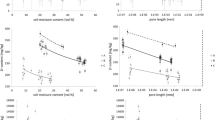Abstract
Though not litigable in most European countries, portable X-ray fluorescence spectrometers (pXRF) provide cost- and time-effective as well as prompt information about hot spots of inorganic soil contaminants. The quality of aqua regia analysis of contaminants can be approximated by a thorough sample preparation, i.e., homogenization, grinding, and sieving of the examined soil before pXRF measurement is carried out. However, elaborate sample preparation causes a trade-off in terms of the desired straightforwardness of the pXRF method. For a first assessment of the in situ accuracy of pXRF measurements, two equal pXRF devices were used in parallel to determine the contents of As, Cu, Fe, Mn, Pb, Rb, Sr, Zn, and Zr of 9 identical points of a riparian soil profile. Maximum measurement values were not restricted to one pXRF device, but changed from element to element. Pearson correlation coefficients of the parallel measurements varied between 0.07 (Cu) and 0.80 (Zn), reflecting small-scale heterogeneity of the soil constituents as well as element-specific interferences. For each element, overall deviations between measurement parallels were expressed as the root-mean-square error (RMSE) and contrasted against the element-specific information depth in soil, i.e., the depth interval, from which the received spectral signals originate. From this, a gradual relation could be derived: The greater the information depth, the more stable the measured element value turns out. This context should be taken into account, when interpreting contents of elements with small atomic numbers.




Similar content being viewed by others
References
Berger, M., Zou, L., & Schleicher, R. (2009). Analysis of sulfur in the copper basin and muddy river sites. International Journal of Soil, Sediment and Water, 2(3), Article 1, 18 pp.
BMUNR (Bundesministerium für Umwelt, Naturschutz und Reaktorsicherheit) (1998). Gesetz zum Schutz vor schädlichen Bodenveränderungen und zur Sanierung von Altlasten (Bundes-Bodenschutzgesetz- BBodSchG) (in German). BGBl. I p. 502.
Chakraborty, S., Man, T., Paulette, L., Deb, S., Li, B., Weindorf, D. C., & Frazier, M. (2017). Rapid assessment of smelter/mining soil contamination via portable X-ray fluorescence spectrometry and indicator kriging. Geoderma, 306, 108–119.
DIN (German Institute of Standardization). (1997). DIN ISO 11466:06.97, Bodenbeschaffenheit – Extraktion in Königswasser löslicher Spurenelemente (in German). Beuth, Berlin.
FABOST (Fachstelle Bodenschutz Kanton Zürich). (2012). Merkblatt - Untersuchung des Bodens mittels mobiler Röntgenfluoreszenz-Spektrometrie und Vergleich mit Resultaten nach VBBo (in German). 4 pp.
Ge, L., Lai, W., & Lin, Y. (2005). Influence of and correction for moisture in rocks, soils and sediments on in situ XRF analysis. X-Ray Spectrometry, 34, 28–34.
Geuß, U., & Hangen, E. (2019). Einsatz eines pRFA-Gerätes zur räumlichen Abgrenzung oberflächennaher Bodenbelastungen (in German with English summary). Bodenschutz, 2(2019), 66–70.
Hangen, E., & Vieten, F. (2016). Influence of soil pore length upon portable X-ray fluorescence spectrometer measurements of elements in soils. Water, Air, and Soil Pollution, 227, 1–7.
Horta, A., Malone, B., Stockmann, U., Minasny, B., Bishop, T. F. A., McBratney, A. B., Pallasser, R., & Pozza, L. (2015). Potential of integrated field spectroscopy and spatial analysis for enhanced assessment of soil contamination: a prospective review. Geoderma, 241, 180–209.
Kalnicky, D. J., & Singhvi, R. (2001). Field portable XRF analysis of environmental samples. Journal of Hazardous Materials, 83, 93–122.
Markowicz, A. A. (2008). Quantification and correction procedures. In P. J. Potts & M. West (Eds.), Portable X-ray fluorescence spectrometry: capabilities for in situ analysis (pp. 13–38). Cambridge: The Royal Society of Chemistry.
Migaszewski, Z. M., Gałuszka, A., & Dołęgowska, S. (2015). The use of FPXRF in the determinations of selected trace elements in historic mining soil in the Holy Cross Mts., south-central Poland. Geological Quarterly, 59, 248–256.
Schneider, A. R., Cances, B., Breton, C., Ponthieu, M., Morvan, X., Conreux, A., & Marin, B. (2015). Comparison of field portable XRF and aqua regia/ICPAES soil analysis and evaluation of soil moisture influence of FPXRF results. Journal of Soils and Sediments, 2, 11 pp.
Shuttleworth, E. L., Evans, M. G., Hutchinson, S. M., & Rothwell, J. J. (2014). Assessment of lead contamination of peatlands using field portable XRF. Water, Air, and Soil Pollution, 22, 1–13.
US EPA/ERT (United States Environmental Protection Agency/Environmental Response Team). (1991). Field portable X-ray fluorescence. Quality Assurance Technical Information Bulletin, 1(no. 4).
US EPA (United States Environmental Protection Agency) (1998): Environmental technology verification report. Field-portable X-ray fluorescence analyzer. Niton Xl Spectrum Analyzer. Report number EPA/600/R-97/150, 93 pp.
US EPA (United States Environmental Protection Agency) (2007): Field portable X-ray fluorescence spectrometry for the determination of elemental concentrations in soil and sediment. URL https://www.epa.gov/sites/production/files/2015-12/documents/6200.pdf (access on 24 September 2019).
Acknowledgments
The authors thank Mathieu Bauer, Thermo Fisher Scientific Inc., for support in the calculation of the soil information depths.
Funding
This study was financially supported by the European Union, the Czech Ministry of Agriculture, and the Bavarian Ministry of Environmental and Consumer Protection under grant 146 of the European Regional Development Fund “Bavaria–Czech Republic.”
Author information
Authors and Affiliations
Corresponding author
Additional information
Publisher’s note
Springer Nature remains neutral with regard to jurisdictional claims in published maps and institutional affiliations.
Rights and permissions
About this article
Cite this article
Hangen, E., Čermák, P., Geuß, U. et al. Information depth of elements affects accuracy of parallel pXRF in situ measurements of soils. Environ Monit Assess 191, 661 (2019). https://doi.org/10.1007/s10661-019-7869-2
Received:
Accepted:
Published:
DOI: https://doi.org/10.1007/s10661-019-7869-2




